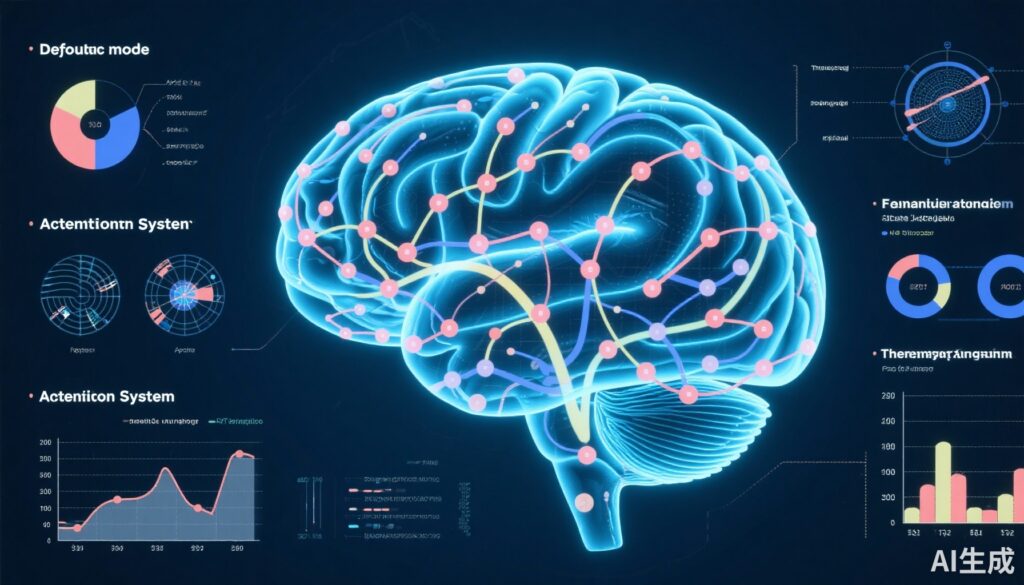Highlights
- Whole-brain functional connectivity (FC) robustly predicts multidimensional treatment outcomes in patients with internalizing psychopathologies (IPs) across diagnoses and therapies.
- Predictive neural signatures prominently involve the default mode network (DMN) and dorsal/ventral attention networks, supporting their transdiagnostic relevance.
- Machine learning models leveraging pretreatment FC generalize across cognitive-behavioral therapy, SSRIs, and supportive therapy, underscoring FC’s utility in precision psychiatry.
- Integrative approaches combining multi-dimensional clinical outcomes and whole-brain FC yield superior predictive performance compared to reduced models.
Background
Internalizing psychopathologies (IPs), encompassing depression, anxiety, and related disorders, represent a significant global public health burden due to their prevalence, chronicity, and heterogeneity in treatment response. Precision medicine approaches aim to tailor interventions based on individual neurobiological and clinical characteristics, but predictive biomarkers remain insufficiently validated. Functional connectivity (FC) measured via resting-state functional MRI advances understanding of neural circuit dysfunction underpinning IPs. Emerging research evaluates whether baseline FC patterns can predict multidimensional treatment responses transdiagnostically and across therapeutic modalities, a crucial step towards personalized psychiatry.
Key Content
Recent Evidence on Functional Connectivity Predicting Treatment Outcomes in IPs
The landmark prognostic study by Zhang et al. (2025) rigorously analyzed pretreatment whole-brain FC and clinical data from 181 patients with IPs randomized to 12-week cognitive-behavioral therapy (CBT), selective serotonin reuptake inhibitor (SSRI) treatment, or supportive therapy (ST). Employing a regularized canonical correlation analysis, the model predicted multidimensional outcomes including depression, anxiety, worry, rumination, and emotion regulation. Predictions were statistically significant at the individual level (r=0.37, p=0.009) and generalized across diagnoses (r=0.24, p=0.02) and treatments (ST: r=0.28; SSRI: r=0.39; CBT: r=0.32).
Neural connections contributing substantially to predictive models were widely distributed but featured prominently within the default mode network (DMN) and dorsal/ventral attention networks. Models restricting the FC to fewer neural systems or outcome domains suffered diminished prediction accuracy, underscoring the importance of comprehensive, whole-brain approaches paired with rich clinical phenotyping.
Contextualizing with Related Functional Connectivity and Treatment Studies
Complementary research supports the predictive value of FC in treatment-resistant depression (Balsters et al., 2024) and late-life depression (Smith et al., 2025), where FC within frontoparietal and default mode networks correlates with cognitive function and treatment remission. Accelerated functional connectivity-guided repetitive transcranial magnetic stimulation (rTMS) targeting dorsolateral and dorsomedial prefrontal cortices has demonstrated rapid antidepressant effects associated with FC changes, emphasizing circuit-specific neuromodulation guided by connectivity biomarkers (Lee et al., 2025).
In anxiety disorders, transcutaneous auricular vagus nerve stimulation (taVNS) modulates basal forebrain connectivity with sensory and prefrontal cortices, with baseline FC predicting symptom improvements, suggesting FC’s relevance across internalizing spectrums (Wang et al., 2025). Furthermore, EEG FC in delta bands has been proposed as a biomarker for MDD symptom clusters and antidepressant response, highlighting multimodal FC assessment (Kim et al., 2024).
Telehealth-delivered CBT for comorbid insomnia in fibromyalgia patients improved sleep quality and normalized salience network connectivity, illustrating FC’s role in capturing neurobiological changes in diverse internalizing-related conditions (Patel et al., 2024).
Methodological Advances and Implications for Clinical Translation
Predictive modeling combining machine learning with regularized canonical correlation analysis emphasizes multidimensional outcome assessment and whole-brain FC features, encompassing distributed neural networks rather than singular regions. This approach aligns with the recognized network-centric pathophysiology of psychiatric disorders.
Cross-trial generalizability, demonstrated through prediction across randomized controlled trial cohorts and therapies, supports clinical feasibility. Integrating neuroimaging with clinical and behavioral markers promises enhanced precision in selecting optimal treatments among pharmacotherapy, psychotherapy, and supportive modalities.
Expert Commentary
The findings underscore the utility of functional connectivity as a transdiagnostic biomarker predicting treatment response in internalizing psychopathologies. The pronounced involvement of the DMN and attention networks corroborates their roles in self-referential processing, emotion regulation, and cognitive control, dysfunctions central to IP symptomatology.
Limitations include the relatively young sample age (mean ~28 years), potentially limiting generalizability to older populations or those with treatment-resistant phenotypes. Further, while FC predicts multidimensional symptom changes, mechanistic causality remains to be elucidated.
Guidelines for precision psychiatry are in nascent stages, but mounting evidence advocates for multimodal biomarkers integrating FC, structural imaging, genetics, and clinical profiling. Real-world implementation requires scalable neuroimaging protocols and computational frameworks.
Biologically, FC alterations may reflect synaptic plasticity and network efficiency modulated by therapies, offering objective readouts to monitor treatment effects. Future work should explore longitudinal FC dynamics and interactions with molecular biomarkers to refine predictive algorithms.
Conclusion
Robust evidence supports baseline whole-brain functional connectivity patterns as reliable predictors of transdiagnostic, multidimensional treatment outcomes in internalizing psychopathologies across cognitive-behavioral therapy, SSRI pharmacotherapy, and supportive therapy. FC signatures centered on the default mode and attention networks offer mechanistic and clinical utility, heralding a new era of precision psychiatry. Advancing these findings into clinical practice necessitates methodological standardization, larger multisite validations, and integration with complementary biomarkers.
References
- Zhang K, Klumpp H, Jimmy J, Phan KL, Milad MR, Wen Z. Functional Connectivity Predicting Transdiagnostic Treatment Outcomes in Internalizing Psychopathologies. JAMA Netw Open. 2025;8(9):e2530008. doi:10.1001/jamanetworkopen.2025.30008. PMID: 40900592; PMCID: PMC12409597.
- Lee SY, et al. A sequential dual-site repetitive transcranial magnetic stimulation for major depressive disorder: A randomized clinical trial. Cell Rep Med. 2025;6(10):102402. doi:10.1016/j.xcrm.2025.102402.
- Wang X, et al. Baseline functional connectivity of the basal forebrain-cortical circuit predict taVNS treatment response in primary insomnia: a randomized controlled trial and fMRI study. BMC Med. 2025;23(1):412. doi:10.1186/s12916-025-04126-7.
- Kim J, et al. In perspective of specific symptoms of major depressive disorder: Functional connectivity analysis of electroencephalography and potential biomarkers of treatment response. J Affect Disord. 2024;367:944-950. doi: 10.1016/j.jad.2024.08.139.
- Smith MT, et al. Brain-cognition relationships and treatment outcome in treatment-resistant late-life depression. Res Sq [Preprint]. 2025. doi:10.21203/rs.3.rs-6340032/v1.
- Patel K, et al. Telehealth-delivered cognitive behavioral therapy normalizes salience network functional connectivity in fibromyalgia with insomnia. Brain Imaging Behav. 2024;18(6):1376-1384. doi:10.1007/s11682-024-00925-3.



